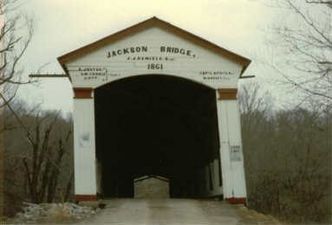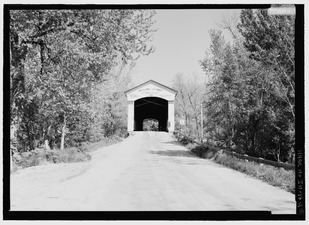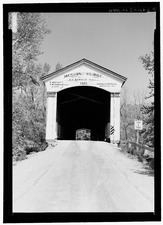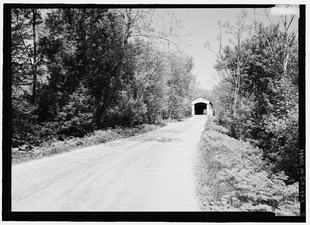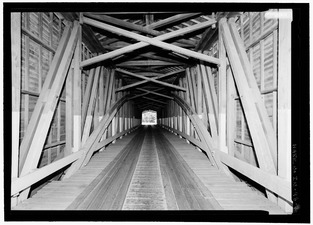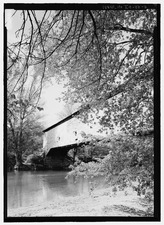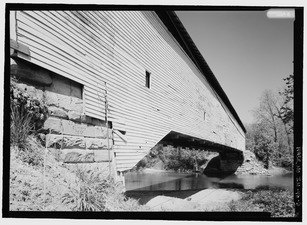Jackson Covered Bridge facts for kids
Quick facts for kids Jackson Covered Bridge |
|
|---|---|

Jackson Covered Bridge c. 2009
|
|
| Coordinates | 39°52′48.09″N 87°16′56.63″W / 39.8800250°N 87.2823972°W |
| Carries | Bloomingdale Road (C.R.25) |
| Crosses | Sugar Creek, Parke County, Indiana |
| Locale | Rockport, Parke, Indiana, United States |
| Official name | Jackson Covered Bridge |
| Other name(s) | Rockport Bridge or Wright's Mill Bridge |
| Named for | Andrew Jackson |
| Maintained by | Parke County |
| WGCB # | 14-61-28 |
| Characteristics | |
| Design | Double Burr arch truss bridge, double king post |
| Material | Hewn stone (foundations) |
| Trough construction | Wood |
| Total length | 225 ft (68.6 m) (includes 9 ft (2.7 m) overhangs on each end) |
| Width | 16 ft (4.9 m) |
| Longest span | 207 ft (63.1 m) |
| Number of spans | 1 |
| Clearance above | 18 ft (5.5 m) |
| History | |
| Construction cost | $8,000 plus subscriptions |
|
Jackson Covered Bridge (#19)
|
|
|
U.S. Historic district
Contributing property |
|
| Lua error in Module:Location_map at line 420: attempt to index field 'wikibase' (a nil value). | |
| Built | 1861 |
| Built by | J. J. Daniels |
| Part of | Parke County Covered Bridges TR (ID64000193) |
| NRHP reference No. | 78000393 |
| Added to NRHP | December 22, 1978 |
The Jackson Covered Bridge, also known as the Rockport Covered Bridge, is a historic bridge located in the small community of Rockport, in Parke County, Indiana, USA. It crosses Sugar Creek and is a famous landmark in the area.
Contents
Building the Jackson Bridge
The Jackson Covered Bridge was built in 1861 by J. J. Daniels, a very skilled bridge builder. It's special because it's the oldest bridge he built that is still standing today! The bridge is a "covered bridge," meaning it has a roof and sides. This design protects the wooden parts from rain and snow, helping the bridge last much longer.
The Bridge's Design
The Jackson Bridge uses a strong design called a Double Burr arch truss bridge. This means it has two large wooden arches that help support the weight, combined with a criss-cross pattern of wooden beams. It's built on a base of large, cut stones, making it very sturdy.
Life Around the Bridge Site
Before the bridge was built, the area around Sugar Creek was a busy place. A man named Prior Wright had built a mill there in 1848. This mill helped process grain. Back then, people would build large, flat boats called flatboats to carry goods down Sugar Creek to markets, especially to New Orleans, when the water was high enough.
Over time, a small town grew around the mill. It included a general store, shops where people made barrels (cooper shop), a blacksmith shop, sawmills, and houses. There was even an iron smelter for a while, which used local coal to make iron.
Getting the Bridge Approved
By late 1860, the people living in the area really wanted a new bridge over Sugar Creek near Wright's Mill. Dr. Hobbs spoke for them and asked the Parke County Commissioners, who were like the local government, to hold a special meeting. On December 28, 1860, they discussed building a bridge.
Just a few days later, on New Year's Day 1861, the commissioners agreed to build two bridges, including the one at Wright's Mill. They said the county would pay $8,000, but the local citizens had to raise the rest of the money themselves.
People quickly got to work! Within two weeks, they had collected $3,307 and gathered 300 signatures from people who supported the idea. Two men, James Johnson and Henry Wolf, were chosen to pick the best spots for the bridges and figure out what they would need.
Construction Begins
J. J. Daniels had actually offered to build bridges in the area back in 1859. When the county opened bids for the new bridges in March 1861, William D. Daniels (J. J. Daniels's relative or business partner) won the contract. The contracts were signed on April 22, and work began.
A company called Brown and Company finished the stone foundations for the bridge by September 16. J. J. Daniels was paid for this work. The Jackson Bridge is special because it's the only bridge J. J. Daniels built in Parke County that has a special stone, called a cornerstone, in its foundation. This stone, located on the south side, reads: "Builder J. J. Daniels 1861."
By November 9, 1861, the bridge was ready for its final check by the county commissioners. Just two days later, Daniels was paid for the Jackson Bridge, which was now complete.
A Bridge with a Message
The Jackson Covered Bridge was built during a very difficult time in American history: the American Civil War. J. J. Daniels wanted to make a clear statement about keeping the country together. He named the bridge after Andrew Jackson, a former U.S. President, to honor Jackson's famous words: "To the Union, it must be preserved." When the bridge was first built, the entrance even had these words written on it: "The Federal Union: It must be preserved."
Today, the Jackson Covered Bridge is the longest single-span covered bridge in Indiana. It was added to the National Register of Historic Places in 1978, recognizing its importance to history.
Gallery
|
|


